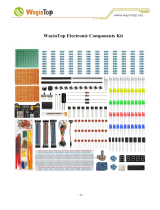Page is loading ...

This capacitive soil moisture sensor distinguishes most of the resistive sensors on the market and uses capacitive sensing to detect soil
moisture. It is made of corrosion resistant material which gives it an excellent service life. Insert it in to the soil around your plants and
impress your friends with real-time soil moisture data! This module includes an on-board voltage regulator which gives it an operating
voltage range of 3.3 ~ 5.5V. It is perfect for low-voltage MCUs, both 3.3V and 5V. For compatibility with a Raspberry Pi it will need an
ADC converter. This soil moisture sensor is compatible with our 3-pin "Gravity" interface, which can be directly connected to the Gravity
I/O expansion shield.
Specification
Operating Voltage: 3.3 ~ 5.5 VDC
Output Voltage: 0 ~ 3.0 VDC
Interface: PH2.0-3P
Size: 98 x 23mm (LxW)
Tutorial
Connection Diagram
1. Connect the sensor and main control board as shown

Calibration Code
1. A calibration process is required before detecting soil moisture.
2. Burn the calibration code to the Arduino main control board.
3. Open the serial port monitoring assistant.
void setup() {
Serial.begin(9600); // open serial port, set the baud rate to 9600 bps
}
void loop() {
int val;
val = analogRead(0); //connect sensor to Analog 0
Serial.print(val); //print the value to serial
delay(100);
}
Calibration step
Dry humidity calibration
Calibration instructions: Define a measurement range by reading the values of the sensor in air and water separately.
Open the serial port monitor and set the baud rate to 9600.
First place the sensor in the air to read the analog value, which represents the reading when dry. Then take a glass of water and insert
the sensor into the water to a certain depth (marking, this is the depth you will insert into the soil), must not exceed the red warning line!
And record the analog value read at this time, representing 100% humidity. (The output data is inversely proportional to humidity and the
output in water is the smallest.) The insertion depth is recommended as shown.

Interval setting
Because the sensor value is affected by the depth of the soil and the tightness of the soil, only the relative humidity of the soil can be
detected. We divide the range of humidity into three equal parts, which means dry, wet and very humid. The two data previously
recorded are the humidity interval. For example, the reading in the air is 520, and the reading in the water is 260, so that it can be
divided into (520, 430], (430, 350), (350, 260). These three intervals represent dry, wet, and very humid.
Note: This sensor will monitor the soil moisture according to the principle of capacitive sensing, so put in different soil moisture,
tightness, insertion depth will reflect different humidity, even in the same place, the same depth, in the second insertion, due to the first
pull out has caused the soil Loose, the humidity that may be read will be lower than the first time.
Note: Humidity is inversely proportional to the reading.
Test code
Enter the two sets of recorded data into your test code.
/***************************************************
This example reads Capacitive Soil Moisture Sensor.
Created 2015-10-21
By berinie Chen <[email protected]>
GNU Lesser General Public License.
See <http://www.gnu.org/licenses/> for details.
All above must be included in any redistribution
****************************************************/
/***********Notice and Trouble shooting***************
1.Connection and Diagram can be found here
2.This code is tested on Arduino Uno.
****************************************************/
const int AirValue = 520; //you need to change this value that you had recorded in the air
const int WaterValue = 260; //you need to change this value that you had recorded in the water
int intervals = (AirValue - WaterValue)/3;
int soilMoistureValue = 0;
void setup() {
Serial.begin(9600); // open serial port, set the baud rate to 9600 bps
}
void loop() {
soilMoistureValue = analogRead(A0); //put Sensor insert into soil
if(soilMoistureValue > WaterValue && soilMoistureValue < (WaterValue + intervals))
{
Serial.println("Very Wet");
}
else if(soilMoistureValue > (WaterValue + intervals) && soilMoistureValue < (AirValue - intervals))
{
Serial.println("Wet");
}

else if(soilMoistureValue < AirValue && soilMoistureValue > (AirValue - intervals))
{
Serial.println("Dry");
}
delay(100);
}
/


